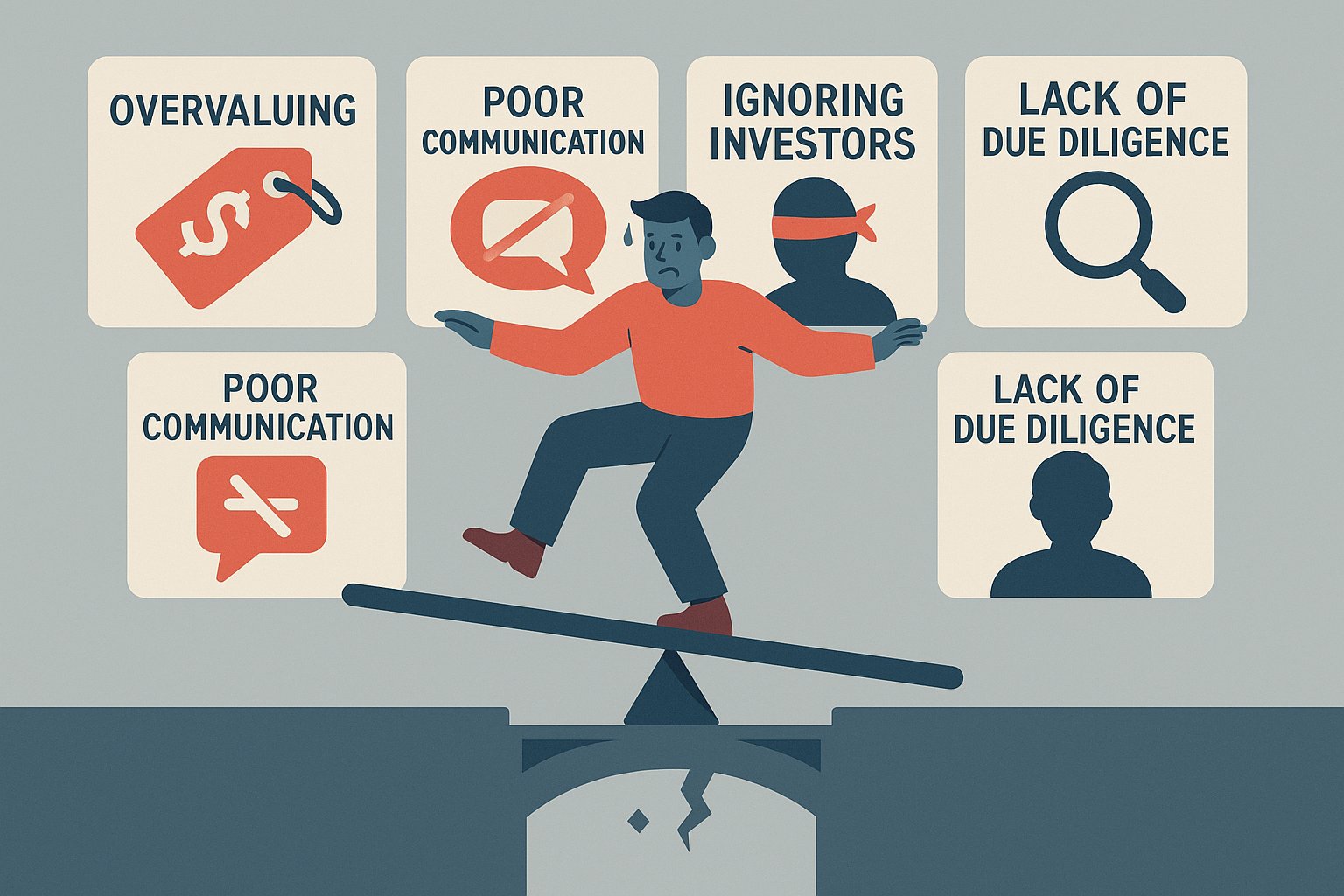From Promise to Pitfall
Equity crowdfunding has revolutionized how startups raise capital, inviting a diverse array of investors to participate in early-stage ventures alongside traditional financiers. Platforms like Republic, SeedInvest, and Crowdcube democratize access to equity, enabling founders to secure funding, validate market demand, and build a passionate investor community—all in one campaign. Yet this promise of streamlined fundraising masks a landscape riddled with pitfalls. While the right campaign can accelerate growth, missteps along the way can lead to missed targets, regulatory headaches, and damaged reputations. Founders often set out with enthusiasm, only to discover that equity crowdfunding demands rigorous preparation, strategic finesse, and unwavering attention to detail.
In this comprehensive exploration, we jump into the most common mistakes that founders encounter on the equity crowdfunding path. From underestimating the research required to mismanaging investor relationships post-funding, each misstep carries real-world consequences. By unpacking these errors—illustrated through real campaign anecdotes and expert insights—we provide a roadmap for avoiding them. Whether you’re preparing your first raise or refining your second, understanding where others have stumbled equips you to navigate the process more effectively. Ultimately, successful equity crowdfunding hinges not merely on a great idea, but on meticulous execution across legal, financial, marketing, and operational domains. Read on to discover where founders most frequently falter—and how you can forge a smoother, more successful fundraising campaign.
Poor Preparation and Lack of Market Research
Many founders jump into equity crowdfunding with minimal groundwork, relying on enthusiasm to carry their campaign forward. Skipping thorough market research is a critical error. Without clear data on target customer segments, competitive landscapes, and potential barriers to adoption, founders cannot craft a pitch that resonates with sophisticated investors. Insufficient research also leads to misaligned funding goals: too low, and the campaign stalls early; too high, and it deters backers who question viability. Effective preparation demands building a detailed investor deck that incorporates market size estimates, customer personas, and competitor analyses. Founders who invest the time to validate assumptions through surveys, focus groups, or pilot programs enter the fundraising arena with a credibility that translates directly into investor confidence and momentum.
Setting Unrealistic Valuation Expectations
Valuation is at once the most pivotal and the most misunderstood element of any equity crowdfunding campaign. Founders frequently overvalue their startups, driven by optimism or pressure to maximize equity retention. High valuations can backfire by placing your campaign above the comfort zone of average investors, leading to sluggish pledge rates or unmet targets. Conversely, undervaluing your company risks unnecessary dilution and may hamper future funding rounds. The solution lies in adopting rigorous valuation methodologies—such as Comparable Company Analysis, Discounted Cash Flow projections tailored to your stage, and the Venture Capital method—to arrive at a defensible pre-money valuation. When founders transparently communicate the rationale behind their valuation, grounded in data and peer benchmarks, they foster trust and align expectations with potential backers.
Weak Storytelling and Pitch Presentation
A compelling narrative distinguishes a campaign that scratches its funding goal from one that soars past it. Founders often focus excessively on product features, neglecting the human story that connects emotionally with investors. A successful pitch weaves together your origin story, market opportunity, traction milestones, and vision for the future into a cohesive storyline. Visual elements—high-quality prototype images, concise explainer videos, and infographics—should complement, not overwhelm, your written narrative. Remember that equity investors look for both passion and professionalism; a pitch deck marred by sloppy design or jargon-heavy explanations can undermine perceived competence. Investing in professional copywriting and design services, or collaborating with experienced advisors to refine your narrative flow, ensures that your pitch captivates and converts.
Ignoring Legal and Compliance Requirements
Equity crowdfunding exists within a strict regulatory framework designed to protect investors. Founders who overlook or underestimate these obligations invite costly delays, fines, or even campaign suspension. Common mistakes include failing to register offerings under the appropriate securities laws, neglecting to file required disclosures, and omitting investor protections such as transfer restrictions or voting rights details. Additionally, cross-border campaigns must navigate varying regulations in each jurisdiction where they solicit investment. Engaging experienced securities counsel early in the process is not optional—it’s essential. Legal advisors guide the preparation of offering memoranda, ensure compliance with fundraising ceilings, and help draft subscription agreements that align with platform standards. By treating legal diligence as integral to campaign planning, founders avoid last-minute scrambles and project a tone of professionalism that reassures backers.
Neglecting Investor Communication and Transparency
Post-launch momentum hinges on robust, ongoing communication. Founders who treat updates as an afterthought miss critical opportunities to sustain engagement, answer emerging questions, and convert fence-sitters. A transparent communication strategy includes regular campaign updates—milestone celebrations, prototype breakthroughs, and stretch goal reveals—shared through platform channels, email newsletters, and social media. Equally important is timely responsiveness to investor inquiries; unanswered questions in comment sections can seed doubt and erode credibility. Beyond formal updates, founders should establish feedback loops—polls, AMAs (Ask Me Anything) sessions, and direct outreach—to incorporate investor input into product development or reward design. This two-way dialogue transforms passive contributors into active evangelists, amplifying your campaign’s reach organically and reinforcing trust through openness.
Mismanaging Financial Projections and Key Metrics
While equity investors understand the uncertainties inherent in startups, they still require evidence of financial discipline. Founders often err by presenting unrealistic revenue scenarios or incomplete expense estimates, leading investors to question the depth of their financial acumen. Robust projections should include multi-year income statements, cash flow forecasts, and sensitivity analyses under different market conditions. Highlight key performance indicators—customer acquisition cost, lifetime value, monthly recurring revenue—and explain the assumptions behind each metric. Overlooking the impact of fees, manufacturing costs, or marketing spend on net proceeds can result in underfunded execution plans. Founders who partner with financial advisors or utilize detailed financial modeling tools produce forecasts that withstand investor scrutiny and provide a clear roadmap for capital deployment.
Overlooking Marketing and Community Building
Equity crowdfunding campaigns launch thousands of pitches onto the same digital stage, making discoverability a primary challenge. Founders who rely solely on organic platform traffic rarely reach their targets. A comprehensive marketing plan—combining targeted social ads, influencer partnerships, press outreach, and email marketing—lays the groundwork for a vibrant pre-launch community and a surge of pledges on day one. Community-building efforts should start well before the public campaign, nurturing email lists through content marketing, webinars, and early-bird signups. Collaborating with niche bloggers, industry associations, and specialized forums amplifies your message within relevant audiences. Founders who allocate at least 10–15% of their funding target to marketing investments avoid the “launch and pray” approach, instead engineering a consistent flow of traffic and pledges that sustains momentum throughout the campaign.
Underestimating Fulfillment and Post-Funding Obligations
Securing investment is only half the journey; delivering on promises is equally critical. Founders often underestimate the logistical complexity and cost of fulfilling rewards, equity issuance, or token distributions. Failure to account for shipping costs, legal fees for share issuance, or platform fees can derail budgets and delay backer satisfaction. Moreover, post-funding governance—such as issuing share certificates, convening investor meetings, and providing quarterly reports—demands ongoing administrative effort. Automating these processes via specialized equity management platforms and engaging fulfillment partners early helps founders set realistic timelines and reduces operational headaches. When founders communicate clear fulfillment plans and deliver on schedule, they bolster investor trust and lay the foundation for long-term advocacy and future funding success.
Failing to Build a Strong Advisory Network
No founder is an island, particularly in the high-stakes world of equity crowdfunding. Campaigns that lack external validation often struggle to persuade skeptical investors. Building an advisory board of seasoned entrepreneurs, industry experts, and legal or financial professionals lends authority to your pitch. Advisors contribute strategic guidance, open doors to investor networks, and provide testimonial endorsements that enhance credibility. Founders frequently make the mistake of treating advisors as nominal decorations rather than active partners. Instead, involve advisors in pre-launch rehearsals, incorporate their feedback into pitch materials, and highlight their credentials prominently. A well-curated advisory network not only strengthens your campaign story but also provides practical support across fundraising, product development, and go-to-market execution.
Rushing the Campaign Without Testing
Finally, impatience can undermine even the most promising equity crowdfunding venture. Founders eager to capitalize on market buzz sometimes rush to launch without testing critical elements—pitch videos, reward structures, or landing page conversions. Neglecting A/B testing for headlines, call-to-action buttons, or reward tier names leaves optimization opportunities on the table. Piloting small-scale soft launches or private beta rounds allows founders to gather feedback, refine messaging, and identify fulfillment challenges before going live. While extended pre-launch periods can delay funding, they dramatically increase the likelihood of meeting targets and reducing costly pivots mid-campaign. Founders who balance urgency with validation set themselves up for smoother public launches and greater overall success.
Conclusion: Turning Lessons into Leverage
Equity crowdfunding offers unparalleled opportunities for startups to raise capital, validate market demand, and cultivate a loyal investor community. Yet it is not a shortcut around rigorous planning, strategic execution, and professional discipline. The most common founder mistakes—from insufficient research and unrealistic valuations to weak storytelling and compliance oversights—are avoidable with foresight and preparation. By embracing a holistic approach that integrates market analysis, robust financial modeling, transparent communication, and operational readiness, founders convert potential pitfalls into stepping stones for success. As you embark on your equity crowdfunding journey, remember that each campaign is as much about demonstrating competence and character as it is about raising funds. Learn from the missteps of others, apply these insights proactively, and position your startup to not only meet but exceed its crowdfunding goals—laying the foundation for sustained growth and enduring investor partnerships.




